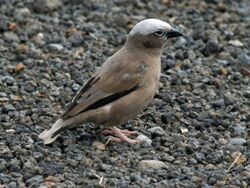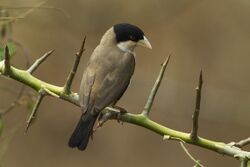Biology:Pseudonigrita
| Pseudonigrita | |
|---|---|

| |
| ↑Pseudonigrita arnaudi, ↓P. cabanisi | |

| |
| Scientific classification | |
| Domain: | Eukaryota |
| Kingdom: | Animalia |
| Phylum: | Chordata |
| Class: | Aves |
| Order: | Passeriformes |
| Family: | Ploceidae |
| Genus: | Pseudonigrita Reichenow, 1903 |
| Type species | |
| Nigrita arnaudi[1] Bonaparte, 1850
| |
| Synonyms | |
| |
Pseudonigrita is a genus of sparrow-like birds in the weaverbird family.
Extant Species
It contains two species, which are both found in eastern Africa:
| Image | Scientific name | Common Name | Distribution |
|---|---|---|---|
 |
Pseudonigrita arnaudi | Grey-capped social weaver | Ethiopia, Kenya, Somalia, South Sudan, Sudan, Tanzania, and Uganda |
 |
Pseudonigrita cabanisi | Black-capped social weaver | central and southern Ethiopia, much of Kenya, a patch of Somalia |
Taxonomy
French naturalist Charles Lucien Bonaparte described the grey-capped social weaver as Nigrita arnaudi in 1850, based on a specimen collected by the French explorer Joseph Pons d'Arnaud around 1841 near Juba on the White Nile.[2] In 1884, the black-capped social weaver was first described by German East-Africa explorer Gustav Fischer and German ornithologist Anton Reichenow as Nigrita cabanisi, based on a specimen collected in 1883 by Fischer in the Pare Mountains. In 1903, Reichenow assigned both species to his newly erected genus Pseudonigrita, because he considered P. arnaudi and P. cabanisi related to weaverbirds (Ploceidae), while the other species Nigrita bicolor, N. canicapillus, N. fusconota and N. luteifrons are negrofinches assigned to the estrildid finches. In 1942, Hans von Boetticher was of the opinion that cabanisi was different enough to assign it to its own genus, and made the new combination Somalita cabanisi.[3][4]
Etymology
Pseudonigrita: Greek: ψευδος pseudos "false"; genus Nigrita Strickland, 1843[5]
Phylogeny
Based on recent DNA-analysis (which did not include P. cabanisi), the genus Pseudonigrita belongs to the group of sparrow weavers (subfamily Plocepasserinae), and is most related to Philetairus socius. This clade is sister to Plocepasser.[6] Provided that the sister relationship between the Pseudonigrita-species is correct, the following tree expresses current insights.
| family Ploceidae |
| |||||||||||||||||||||||||||||||||||||||||||||||||||
References
- ↑ "Ploceidae". The Trust for Avian Systematics. https://www.aviansystematics.org/4th-edition-checklist?viewfamilies=190.
- ↑ Bonaparte, Charles Lucien (1850) (in la). Conspectus generum avium. 1. Lugduni Batavorum: E.J. Brill. p. 444. https://www.biodiversitylibrary.org/page/43560671.
- ↑ "Zwartkapwever" (in nl). http://www.vogelsbekijken.be/zangvogels/blzwevers/Zwartkapwever.html.
- ↑ Boetticher, Hans von (1942). "Der kleine Schwarzkopf-Sperlingsweber". Verhandlungen der Ornithologischen Gesellschaft in Bayern 22 (2): 207–210. http://www.zobodat.at/pdf/Verhandlungen-Ornith-Ges-Bayern_22_2_1942_0207-0210.pdf. Retrieved 2017-04-23.
- ↑ Jobling, J.A. (2017). "Key to Scientific Names in Ornithology". in del Hoyo, J.; Elliott, A.; Sargatal, J. et al.. Handbook of the Birds of the World Alive. Barcelona: Lynx Edicions. https://www.hbw.com/dictionary/definition/pseudonigrita.
- ↑ De Silva, Thilina N.; Peterson, A. Townsend; Bates, John M.; Fernandoa, Sumudu W.; Girard, Matthew G. (2017). "Phylogenetic relationships of weaverbirds (Aves: Ploceidae): A first robust phylogeny based on mitochondrial and nuclear markers". Molecular Phylogenetics and Evolution 109: 21–32. doi:10.1016/j.ympev.2016.12.013. PMID 28012957.
External links
Wikidata ☰ Q1083179 entry
 |

